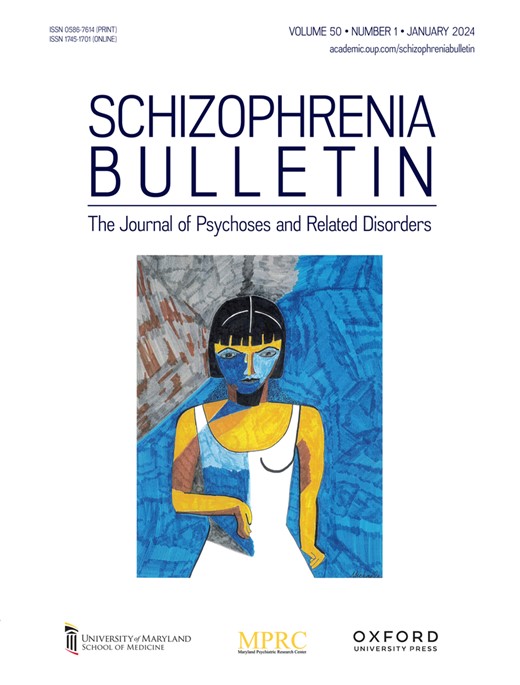Mitochondrial Dysfunction and Cognitive Impairment in Schizophrenia: The Role of Inflammation
IF 5.3
1区 医学
Q1 PSYCHIATRY
引用次数: 0
Abstract
Background and Hypothesis The complex immune-brain interactions and the regulatory role of mitochondria in the immune response suggest that mitochondrial damage reported in schizophrenia (SZ) may be related to abnormalities observed in immune and brain functions. Study Design Mitochondrial DNA copy number (mtDNA CN), a biomarker of mitochondrial function, was assessed in peripheral blood leukocytes (PBLs) of 121 healthy individuals and 118 SZ patients before and after 8 weeks of antipsychotic treatment, and a meta-analysis related to blood mtDNA CN was conducted. Plasma C-reactive protein (CRP) levels in SZ patients were obtained from the medical record system. Spearman correlation analysis and hierarchical linear regression were used to analyze the relationships among mtDNA CN, CRP levels, and cognitive function. A mediation model was constructed using the PROCESS program. Study Results Our results revealed the decreased mtDNA CN in PBLs from SZ patients (P = .05). The meta-analysis supported the decreased blood mtDNA CN in SZ patients (P < .01). The mtDNA CN in PBL was positively correlated with working memory (P = .02) and negatively correlated with plasma CRP levels (P = .039). Furthermore, a lower mtDNA CN in PBL in SZ patients was a significant predictor of worse working memory (P = .006). CRP acted as a mediator with an 8.0% effect. Conclusions This study revealed an association between peripheral mitochondrial dysfunction and cognitive impairment in SZ, with inflammation acting as a mediating effect. Therefore, mitochondrial dysfunction might provide novel targets for new treatments for cognitive impairment in SZ.线粒体功能障碍与精神分裂症的认知障碍:炎症的作用
背景与假设 免疫与大脑之间复杂的相互作用以及线粒体在免疫反应中的调节作用表明,精神分裂症(SZ)中出现的线粒体损伤可能与免疫和大脑功能异常有关。研究设计 对121名健康人和118名精神分裂症患者在接受抗精神病药物治疗8周前后的外周血白细胞(PBLs)中的线粒体DNA拷贝数(mtDNA CN)(线粒体功能的生物标志物)进行了评估,并对血液中的mtDNA CN进行了荟萃分析。SZ患者的血浆C反应蛋白(CRP)水平来自医疗记录系统。采用斯皮尔曼相关分析和分层线性回归分析了mtDNA CN、CRP水平和认知功能之间的关系。使用 PROCESS 程序建立了一个中介模型。研究结果 我们的研究结果显示,SZ 患者 PBL 中的 mtDNA CN 有所降低(P = .05)。荟萃分析支持 SZ 患者血液中的 mtDNA CN 减少(P < .01)。PBL中的mtDNA CN与工作记忆呈正相关(P = .02),与血浆CRP水平呈负相关(P = .039)。此外,在 SZ 患者中,PBL 中较低的 mtDNA CN 可显著预测较差的工作记忆(P = .006)。CRP 起着中介作用,影响率为 8.0%。结论 本研究揭示了外周线粒体功能障碍与 SZ 认知功能障碍之间的联系,炎症起着中介作用。因此,线粒体功能障碍可能为治疗 SZ 认知障碍提供新的靶点。
本文章由计算机程序翻译,如有差异,请以英文原文为准。
求助全文
约1分钟内获得全文
求助全文
来源期刊

Schizophrenia Bulletin
医学-精神病学
CiteScore
11.40
自引率
6.10%
发文量
163
审稿时长
4-8 weeks
期刊介绍:
Schizophrenia Bulletin seeks to review recent developments and empirically based hypotheses regarding the etiology and treatment of schizophrenia. We view the field as broad and deep, and will publish new knowledge ranging from the molecular basis to social and cultural factors. We will give new emphasis to translational reports which simultaneously highlight basic neurobiological mechanisms and clinical manifestations. Some of the Bulletin content is invited as special features or manuscripts organized as a theme by special guest editors. Most pages of the Bulletin are devoted to unsolicited manuscripts of high quality that report original data or where we can provide a special venue for a major study or workshop report. Supplement issues are sometimes provided for manuscripts reporting from a recent conference.
 求助内容:
求助内容: 应助结果提醒方式:
应助结果提醒方式:


